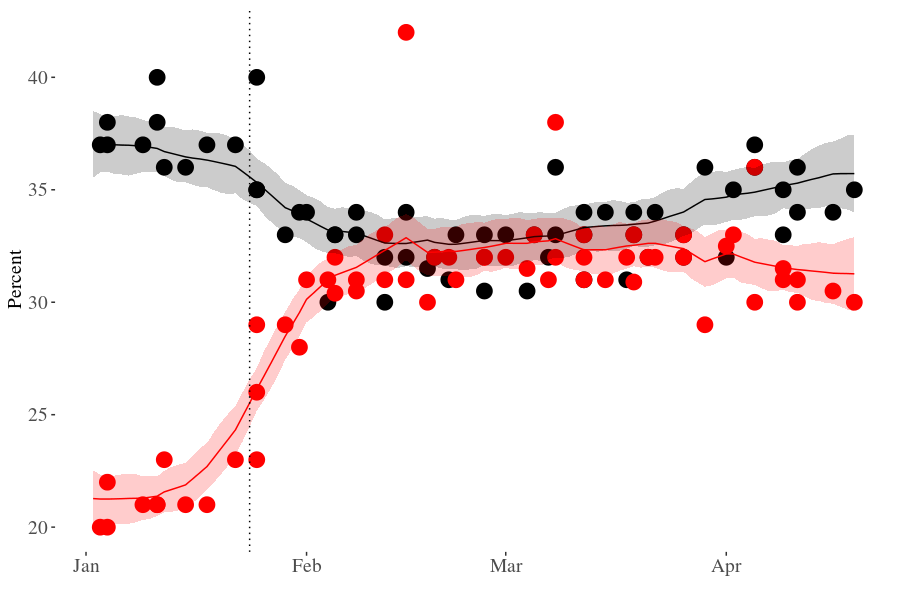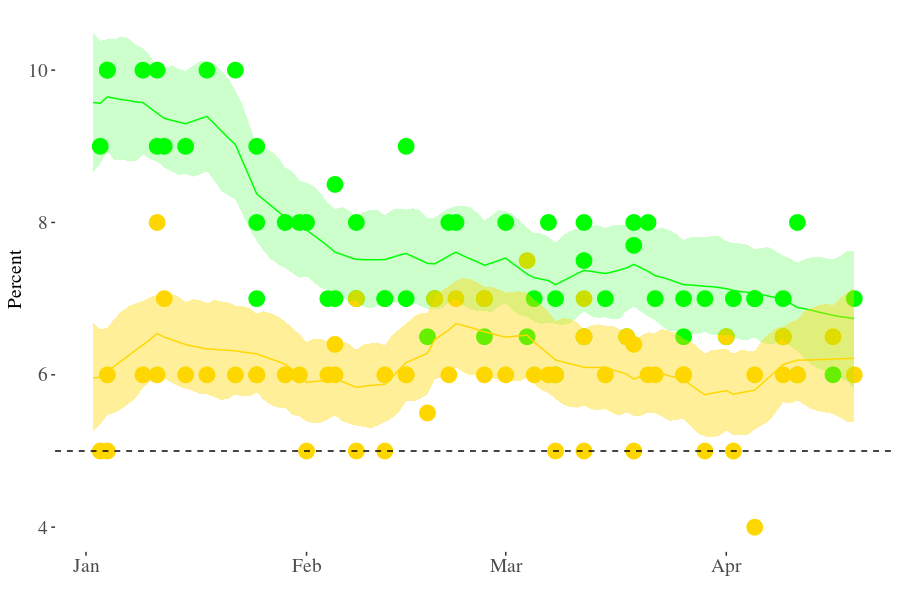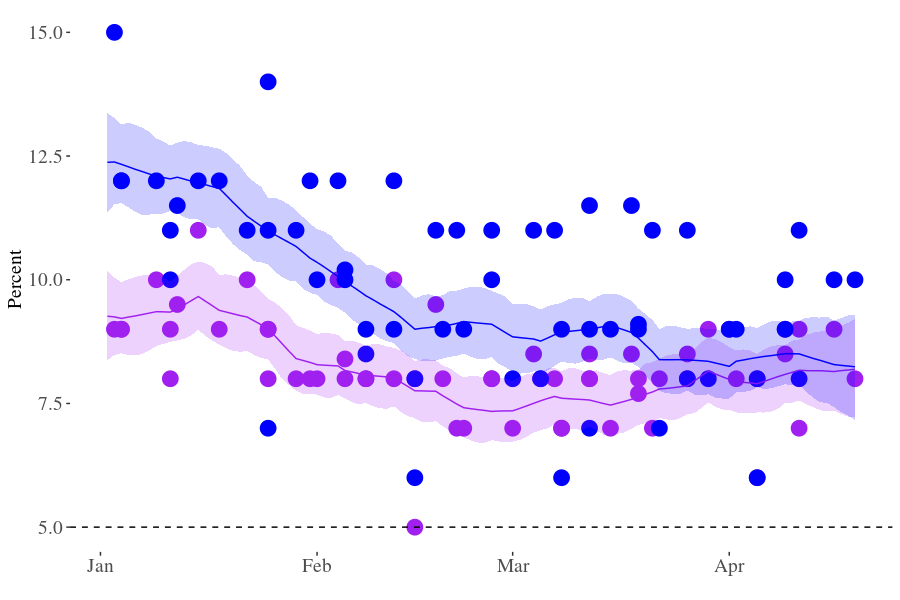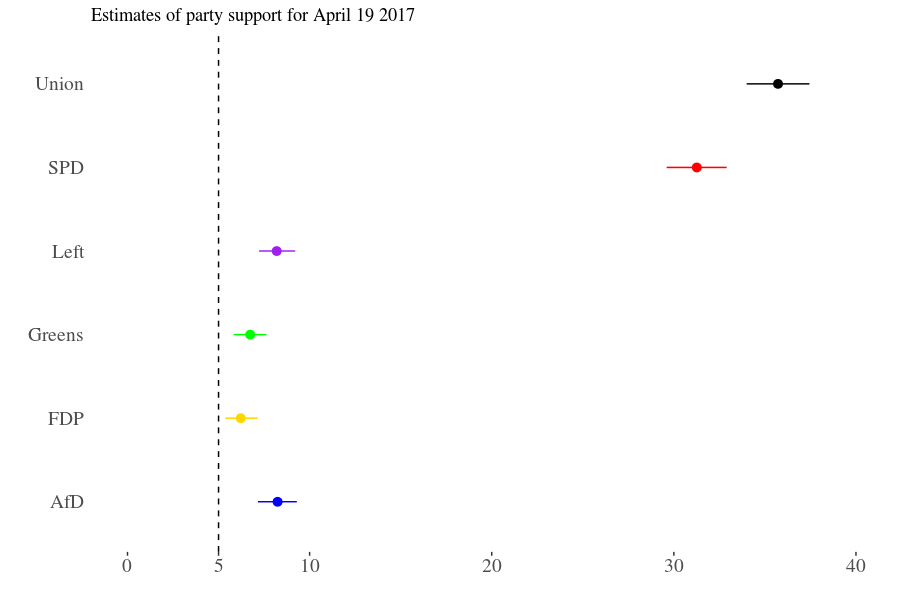On the 108th day of polling …
… my true love gave to me: two Dimap polls, two Forsa polls, two INSA polls, one Emnid poll, and one FGW poll. So the total number of polls in the database stands at 59 now. Not too shabby. However, three companies dominate the pool: Insa (11), Emnid (15), and Forsa (15). It would be good to have more polls from Allensbach, Dimap, FGW, and GMS.
The CDU is leading, but by a small margin
Following the surprise candidacy of Martin Schulz, the SPD made enormous strides, and the two major parties have been neck-on-neck for more than two months. But over the last couple of weeks, the Christian Democrats finally managed to regain a lead over their current coalition partner, although it is a tenuous one compared to their previous standing in the polls. For April 18, the model estimates support for the Christian Democrats at 36 per cent (with a 34-37 per cent credible interval), and support for the SPD at 31 per cent (CI: 30-33).
The FDP and the Greens are still struggling
The Greens have not recovered from the drop they suffered in January. Quite to the contrary, support for them seems to have fallen a bit further during the last four weeks or so. But this movement is well within the margin of error. The FDP, on the other hand, may have recovered a little bit, but again, they are still within the CI they were two, four, or even eight weeks ago. Statistically speaking, support for both parties is indistinguishable at the moment.
The Left and the AfD are remaining neck-on-neck
And the same goes for the Left and the AfD. Support for both parties is estimated at 8 per cent, with a 7-9 per cent credible interval. Infighting within the AfD has reached new heights (lows?), and the party may even split again (by the way, I’m really looking forward to the Hunger Games of this weekend’s party conference), but so far, this has had relatively little effect on their polling results, which are still within the (lower) bound of the credible intervals for March. Conversely, support for the Left may have risen a bit but is still within the (upper) bound of their credible interval for March.
Overall estimates and possible coalitions
From this final graph, it is clear that the credible intervals for all four minor parties overlap at the moment: in all likelihood, they are all somewhere above the electoral threshold and below the ten per cent mark, but there is insufficient evidence for determining how exactly voters rank them at the moment.
For the two major parties, the uncertainty regarding the exact levels of their support is even larger, but the probability that the Christian Democrats are enjoying higher levels of support than the SPD is more than 99 per cent. However, due to the uncertainty about the parties’ standing, the uncertainty regarding the size of this gap is substantial: the credible intervals stretches from 2 to 7 per cent.
Given these estimated levels of support, neither a “civic” (FDP/Christian Democrats) nor a classic leftist (SPD/Green) coalition would be possible. As a consequence of the Christian Democrats’ rising popularity, even a red-red-green coalition would be possible in fewer than 2 per cent of the simulated draws from the posterior joint distribution. A “Jamaica” coalition of Christian Democrats, FDP, and Greens, on the other hand, would command a parliamentary majority in 71 per cent of the simulations. Having a choice between two coalitions would obiously strengthen Merkel’s hand considerably. But once more, remember that these are not predictions but rather (hopefully) plausible estimates of the current state of public opinion.





RT @kai_arzheimer: From the vault: State of the German polls: The CDU edges up, and the AfD is still stable https://t.co/xiogAbNYKS
RT @kai_arzheimer: From the vault: State of the German polls: The CDU edges up, and the AfD is still stable https://t.co/xiogAbNYKS
RT @kai_arzheimer: From the vault: State of the German polls: The CDU edges up, and the AfD is still stable https://t.co/xiogAbNYKS
RT @kai_arzheimer: From the vault: State of the German polls: The CDU edges up, and the AfD is still stable https://t.co/xiogAbNYKS
RT @kai_arzheimer: State of the #German polls: The #CDU edges up, and the #AfD is still stable – kai arzheimer https://t.co/VM8cxyMrM5 http…
RT @kai_arzheimer: State of the #German polls: The #CDU edges up, and the #AfD is still stable – kai arzheimer https://t.co/VM8cxyMrM5 http…
RT @kai_arzheimer: State of the #German polls: The #CDU edges up, and the #AfD is still stable – kai arzheimer https://t.co/VM8cxyMrM5 http…
RT @kai_arzheimer: The blue line is support for #Germany’s #AfD before this weekend’s tumultuous conference. No new polls yet. More: https:…
RT @kai_arzheimer: The blue line is support for #Germany’s #AfD before this weekend’s tumultuous conference. No new polls yet. More: https:…
RT @kai_arzheimer: The blue line is support for #Germany’s #AfD before this weekend’s tumultuous conference. No new polls yet. More: https:…
RT @kai_arzheimer: #Germany: The #FDP and the #Greens are still struggling in the polls https://t.co/Id4M9XqhiO https://t.co/gm6JsEDLLx
RT @kai_arzheimer: Before today’s party conference: The Left and the #AfD are remaining neck-on-neck https://t.co/GNOXlNxJ6o https://t.co/5…